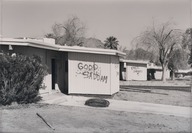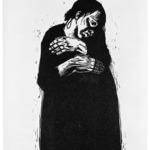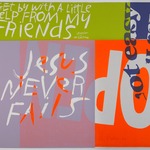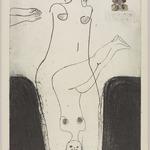
29 Palms: Security and Stability Operations (Good Saddam)
An-My Lê
Elizabeth A. Sackler Center for Feminist Art
An-My Lê, who arrived in the United States from Vietnam as a political refugee in 1975, explores the glorification of war in images of domestic and global U.S. military activity. Lê uses a large-format camera, similar to those employed by Civil War photographers, to document landscapes transformed by conflict. In the series 29 Palms, Lê photographs staged training sites built for American recruits in California’s Mojave Desert. Security and Stability Operations (Good Saddam) depicts former military housing transformed into a seemingly hostile environment when tagged with mock anti-American graffiti, examining the difference between simulated experiences and representations of actual war.
MEDIUM
Gelatin silver photograph
DATES
2003–2004
DIMENSIONS
sheet: 26 1/2 × 38 in. (67.3 × 96.5 cm)
frame: 27 7/8 × 39 3/8 × 1 1/2 in. (70.8 × 100 × 3.8 cm) (show scale)



COLLECTIONS
Elizabeth A. Sackler Center for Feminist Art
ACCESSION NUMBER
2016.34
CREDIT LINE
Gift of Pamela and Arnold Lehman and Patricia and Randall Lewis
MUSEUM LOCATION
This item is not on view
CAPTION
An-My Lê (American, born Vietnam, 1960). 29 Palms: Security and Stability Operations (Good Saddam), 2003–2004. Gelatin silver photograph, sheet: 26 1/2 × 38 in. (67.3 × 96.5 cm). Brooklyn Museum, Gift of Pamela and Arnold Lehman and Patricia and Randall Lewis, 2016.34. © artist or artist's estate (Photo: , 2016.34_PS11.jpg)
EDITION
Edition: 1/5
IMAGE
overall, 2016.34_PS11.jpg., 2018
"CUR" at the beginning of an image file name means that the image was created by a curatorial staff member. These study images may be digital point-and-shoot photographs, when we don\'t yet have high-quality studio photography, or they may be scans of older negatives, slides, or photographic prints, providing historical documentation of the object.
RIGHTS STATEMENT
© An-My Lê
The Brooklyn Museum holds a non-exclusive license to reproduce images of this work of art from the rights holder named here.
The Museum does not warrant that the use of this work will not infringe on the rights of third parties. It is your responsibility to determine and satisfy copyright or other use restrictions before copying, transmitting, or making other use of protected items beyond that allowed by "fair use," as such term is understood under the United States Copyright Act.
For further information about copyright, we recommend resources at the United States Library of Congress, Cornell University, Copyright and Cultural Institutions: Guidelines for U.S. Libraries, Archives, and Museums, and Copyright Watch.
For more information about the Museum's rights project, including how rights types are assigned, please see our blog posts on copyright.
If you have any information regarding this work and rights to it, please contact copyright@brooklynmuseum.org.
If you wish to contact the rights holder for this work, please email copyright@brooklynmuseum.org and we will assist if we can.
RECORD COMPLETENESS
Not every record you will find here is complete. More information is available for some works than for others, and some entries have been updated more recently. Records are frequently reviewed and revised, and we welcome any additional information you might have.

![Untitled (Guanaroca [First Woman])](https://d1lfxha3ugu3d4.cloudfront.net/images/opencollection/objects/size2_sq/2007.15_PS9.jpg)




















